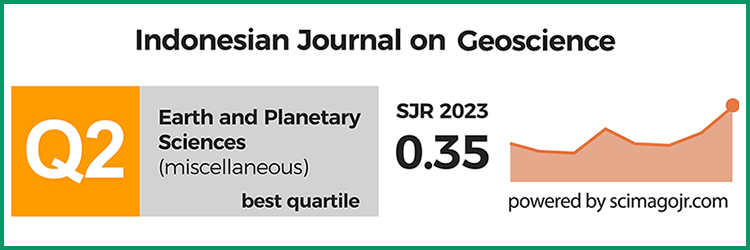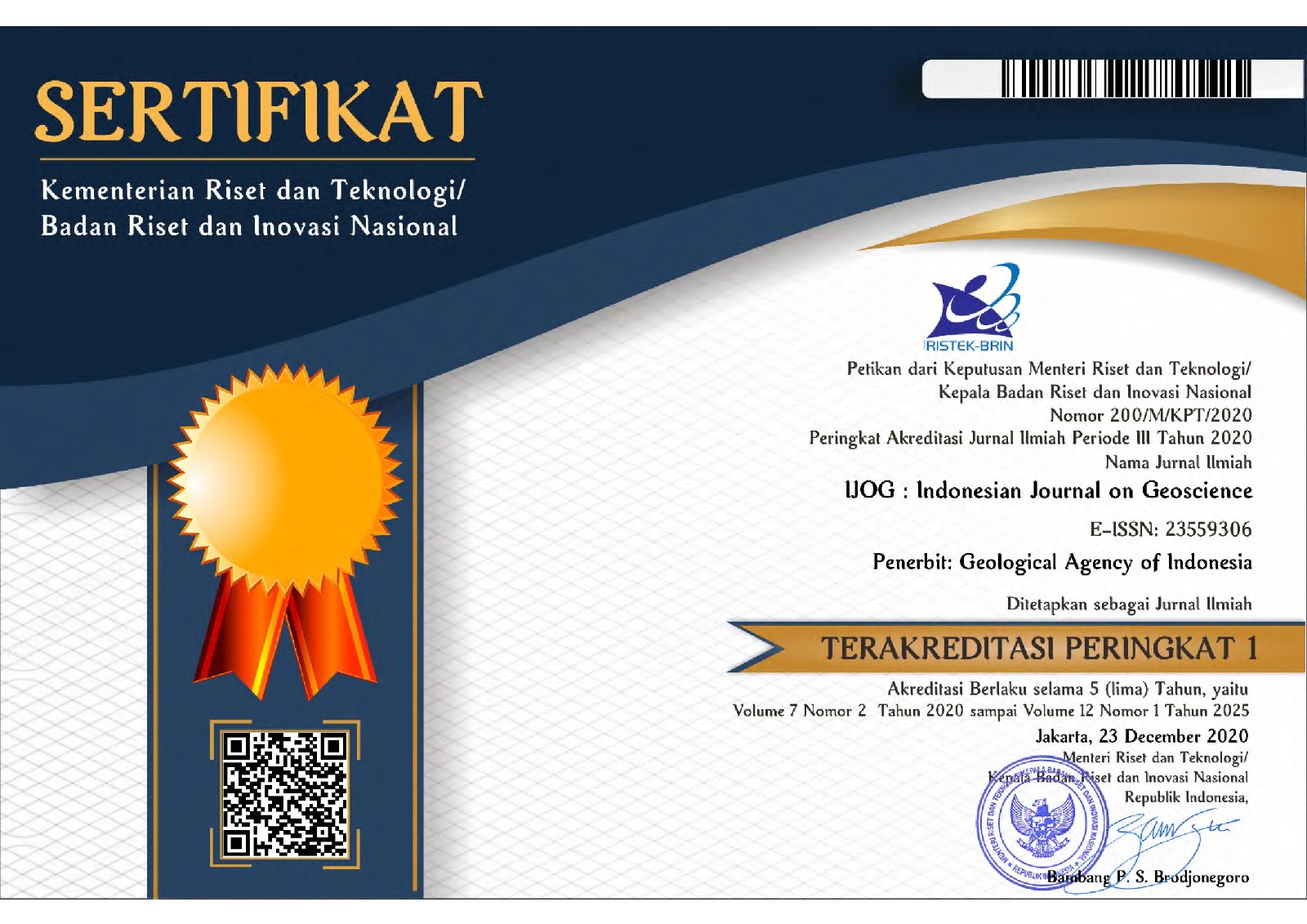Alteration and Vein Textures Associated with Gold Mineralization at the Bunikasih Area, Pangalengan, West Java
DOI:
https://doi.org/10.17014/ijog.5.4.247-261Keywords:
alteration, vein texture, gold mineralization, Bunikasih SariAbstract
The Bunikasih vein system in the Pangalengan district of West Java is a low-sulfidation, adularia sericite epithermal gold deposit. It is hosted by Late Miocene andesitic volcanic and volcanoclastic rocks occurring in the south western margin of Malabar Volcano complex. Gold ore and alteration minerals related to deposition of gold in Bunikasih deposits superimposed on Late Tertiary-Quaternary andesitic formation that were altered and mineralized by some hydrothermal events. The veins consist almost entirely of quartz, with small amounts of adularia, bladed calcite, pyrite, and gold. Gold ore shoots are vertically restricted and are more continuous horizontally. The veins display complex and multi episodic filling with texture characteristics of open space precipitation such us colloform, lattice bladed, crustiform banding, vugs, breccia, and cockade and comb texture. The presence of bladed calcite and silica pseudomorph after bladed calcite suggests that the hydrothermal fluids boiled. In the Cibaliung section of the area, anomalous gold is related to veins trending northeast - southwest, milky quartz with dark grey to black manganese staining is found intermittently for a length of about 800m. The mineralized andesite ore bodies exhibit broad alteration patterns adjacent to mineralization, passing from fresh rock into anargillic, chlorite zone, and then sericite-silica close to mineralization. An argillic assemblage composed of kaolinite with fine-grained pyrite bulb is present in the upper portions and surrounding of the quartz vein system. The veins range from centimeter to meter in size. Of 24 vein samples collected, gold averages up to 0.3 grams per tone ("g/t"), to a high of 24.6 g/t. The Bunikasih epithermal gold deposit was mined by people for more than 10 years, mainly for the gold ore.
References
Adams, S.F., 1920. A microscopic study of vein quartz; Economic Geology, 15, p. 623-664. DOI:10.2113/gsecongeo.15.8.623
Alzwar, M., Akbar, N., and Bachri, S., 1992. Geologi Lembar Garut dan Pameungpeuk, Jawa Barat (1208-6), Skala 1 : 250.000. Pusat Penelitian dan Pengembangan Geologi, Bandung.
Buchanan, L.J., 1981. Precious metal deposits associated with volcanic environments in the Southwest Arizona Geological Society Digest, 14, p.237-262.
Chandra J., 2009. Geologi dan Prospeksi Emas Hidrotermal Daerah Bunikasih, Pangalengan Jawa Barat, Tugas Akhir Sarjana Strata-1 Prodi Teknik Geologi – FITB – ITB, unpublished.
Dong, G., Morrison, G.W., and Jaireth, S., 1995. Quartz Textures in epithermal veins, Queensland – classification, origin, and implication. Economic Geology, v.90, p. 1841-1856. DOI:10.2113/gsecongeo.90.6.1841
Fournier, R.O., 1985a. The behavior of silica in hydrothermal solution, Reviews in Economic Geology, 2, p. 45-61
Morisson, G., Guoyi, D., and Jareith, S., 1990. Textural Zoning in Epithermal Quartz Vein, Amira Project P247, Gold Research Group, James Cook University of North Queensland, p. 33
Shimizu, T., Matsueda, H., Ishiyama, D., and Matsubaya, O., 1998. Genesis of Epithermal Au-Ag Mineralization of the Koryu Mine, Hokkaido, Japan. Economic Geology, 93, p. 303-325. DOI:10.2113/gsecongeo.93.3.303
Urashima, Y., 1956. “Bosa” quartz veins, especially the fine-grained quartz aggregates, of the Konomai mine in Hokkaido, Japan: Hokkaido University. Journal of Faculty of Science, 9, p. 371–387.
Warmada, I.W., 2003. Ore mineralogy and geochemistry of the Pongkor epithermal gold-silver deposit, Indonesia, Clausthal-Zellerfeld. Papierflieger.
Widi, B.N., Sunarya, Y., Judawinata, K., and Setiawan, B., 1997. The Epithermal Gold-Silver-Tellurides Deposits of Citambal-Cineam, Tasikmalaya, West Java, Indonesia. Proceedings of Mineral Exploration Technology in Indonesia, BPP-Technology, Jakarta, paper no. 10, p. 1-18.



















